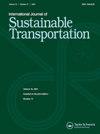Last mile delivery with drones: A carbon emissions comparison
IF 3.1
3区 工程技术
Q2 ENVIRONMENTAL STUDIES
International Journal of Sustainable Transportation
Pub Date : 2024-09-01
DOI:10.1080/15568318.2024.2407150
引用次数: 0
Abstract
The development and potential adoption of drones or unmanned aerial vehicles as delivery vehicles creates incredible opportunities and unique challenges for last mile delivery. This research first presents a last mile delivery fleet model with drones that can be further modified and expanded over time. The model shows the optimal number of drones needed based on deterministic or stochastic demand using both traditional charging and battery swapping. The research then compares the carbon emissions of four delivery modes: traditional internal combustion delivery vehicles, all-electric vehicles, plug-in hybrids, and drones within the context of last mile delivery. Findings reveal that the breakdown of carbon emissions by delivery modality depends on parameter assumptions, ambient temperature, delivery radius, electric grid pollution rate, and number of customers.
使用无人机进行最后一英里配送:碳排放比较
无人机或无人驾驶飞行器作为送货工具的发展和潜在采用,为最后一英里送货创造了难以置信的机遇和独特的挑战。这项研究首先提出了一个最后一英里配送机队模型,该模型可随着时间的推移进一步修改和扩展。该模型显示了基于确定性或随机需求,使用传统充电和电池交换方式所需的最佳无人机数量。然后,研究比较了四种配送模式的碳排放量:传统内燃配送车辆、纯电动汽车、插电式混合动力汽车以及最后一英里配送范围内的无人机。研究结果表明,不同配送方式的碳排放量取决于参数假设、环境温度、配送半径、电网污染率和客户数量。
本文章由计算机程序翻译,如有差异,请以英文原文为准。
求助全文
约1分钟内获得全文
求助全文
来源期刊
CiteScore
8.90
自引率
2.60%
发文量
56
期刊介绍:
The International Journal of Sustainable Transportation provides a discussion forum for the exchange of new and innovative ideas on sustainable transportation research in the context of environmental, economical, social, and engineering aspects, as well as current and future interactions of transportation systems and other urban subsystems. The scope includes the examination of overall sustainability of any transportation system, including its infrastructure, vehicle, operation, and maintenance; the integration of social science disciplines, engineering, and information technology with transportation; the understanding of the comparative aspects of different transportation systems from a global perspective; qualitative and quantitative transportation studies; and case studies, surveys, and expository papers in an international or local context. Equal emphasis is placed on the problems of sustainable transportation that are associated with passenger and freight transportation modes in both industrialized and non-industrialized areas. All submitted manuscripts are subject to initial evaluation by the Editors and, if found suitable for further consideration, to peer review by independent, anonymous expert reviewers. All peer review is single-blind. Submissions are made online via ScholarOne Manuscripts.

 求助内容:
求助内容: 应助结果提醒方式:
应助结果提醒方式:


